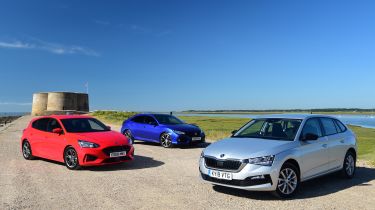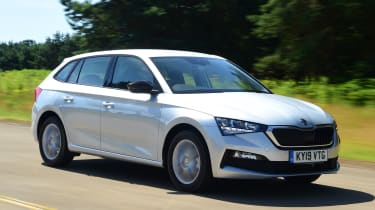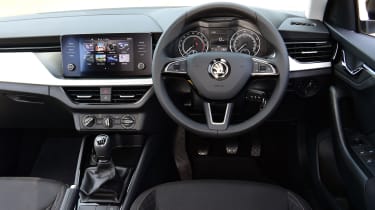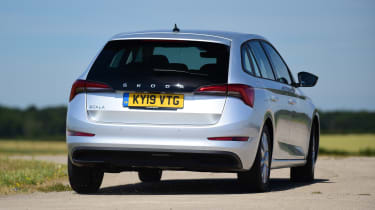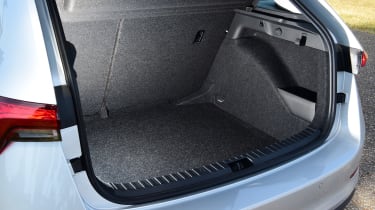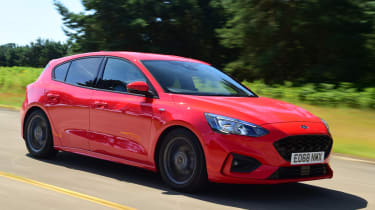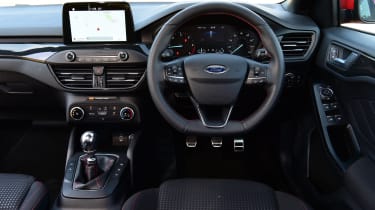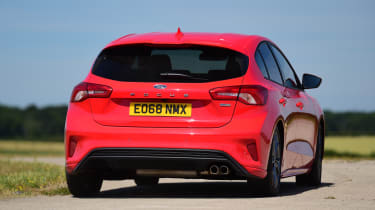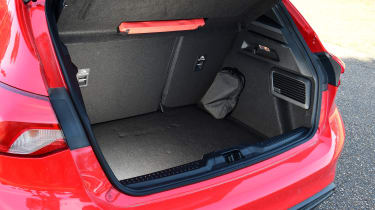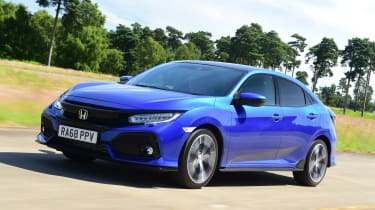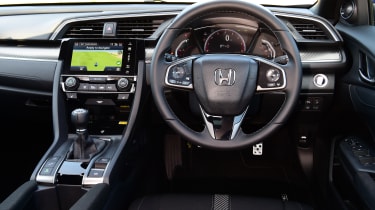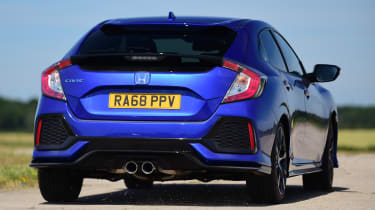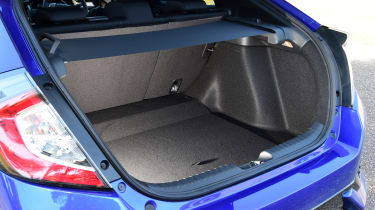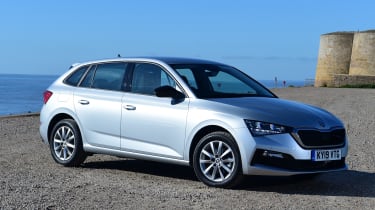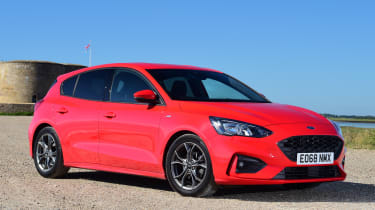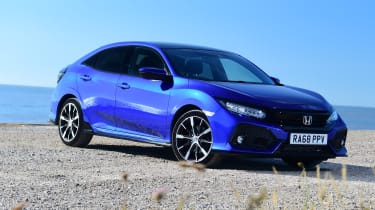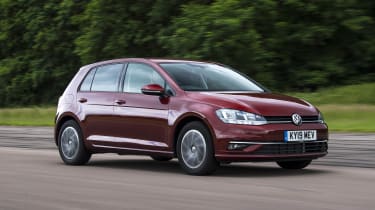Skoda Scala vs Ford Focus vs Honda Civic
We test the brand new Skoda Scala against hatchback royalty - the Ford Focus and Honda Civic
The Skoda Scala shot straight to the top of its class in our first group test in petrol form, even picking up an Auto Express Award in the family hatchback category for good measure.
Yet there’s more to the story, because it has other rivals to face and a different fuel type that we’ve not tested until now. This time it’s the turn of the Scala TDI. Diesel power offers a few advantages, the most important being fuel economy. If you do lots of miles a year and don’t spend much time in cities, it may still be the better choice. Plus these models emit low levels of CO2, so they work well as company cars.
In our last test, the petrol-powered Scala faced the Volkswagen Golf and Kia Ceed, but the family hatch class is highly competitive and the Ford Focus and Honda Civic both offer strong practicality and are available in diesel form to match the Scala’s powertrain.
Each of these two rivals has its own appeal, so we’ve brought all three models together to find out which one makes the most sense as a frugal family car.
Skoda Scala
| Model: | Skoda Scala 1.6 TDI 115 SE |
| Price: | £20,265 |
| Engine: | 1.6-litre 4cyl diesel, 113bhp |
| 0-60mph: | 9.4 seconds |
| Test economy: | 50.1mpg/11.0mpl |
| CO2 | 108g/km |
| Annual road tax: | £145 |
The Scala is the cheapest car in this test, starting from £20,265 in SE form as driven here. It has a 1.6-litre diesel engine with 113bhp and a six-speed manual gearbox.
Used - available now

2023 Skoda
Scala
14,436 milesManualPetrol1.5L
Cash £13,283
2020 Skoda
Scala
13,395 milesManualPetrol1.0L
Cash £11,900
2023 Skoda
Scala
51,983 milesManualPetrol1.0L
Cash £13,387
2023 Skoda
Scala
10,990 milesAutomaticPetrol1.0L
Cash £16,087Design & engineering
The Skoda’s engine is shared with many other models in the Volkswagen Group range. It’s a four-cylinder unit that produces 113bhp and 250Nm of torque, so it has the same power output as the petrol engine we tested last time, yet the diesel has more torque, which is the figure that often affects an engine’s flexibility.
Scalas use an evolution of the MQB architecture that underpins many VW Group cars, and the variation here is called MQB A0. This is mostly used for superminis such as the VW Polo, and the Scala is the biggest car so far on this platform.
It has MacPherson struts at the front and a torsion beam at the back, which is a cheaper and less complex set-up than the Civic’s. But the Skoda’s platform has helped engineers to shed weight, which benefits ride, handling and fuel economy – and despite its cheaper rear suspension, the Skoda doesn’t fall behind in the first of those areas either.
A simple interior design means the Scala feels more upmarket than its low price suggests. That’s also helped by the eight-inch touchscreen display, with Android Auto and Apple CarPlay as standard. Material quality is a match for its rivals’ here; it’s not particularly exciting, but it does the job. The layout of the dashboard is neat and clean, which gives it a more elegant feel, even on this SE trim. This specification is strong for the money and features lane-keep assist, parking sensors, cruise control and air-conditioning as standard.
Driving
The Scala’s diesel engine is torquey, with 250Nm available from just 1,500rpm, so the pulling power is delivered where you want it and easily accessible to help give a relaxed drive. That’s lower down in the rev range than both rivals here, and because the Scala is lighter as well, there’s plenty of flexibility.
The motor is a bit rattly, but isn’t overly noisy, and the slick six-speed manual transmission is satisfying to use, if slightly less precise than its rivals’ gearboxes.
Performance is good, too, because all three models are evenly matched. Just 0.2 seconds separated them in our 0-60mph tests, where the Skoda, Ford and Honda took 9.4, 9.3 and 9.2 seconds respectively. The Scala was quickest in third from 30-50mph, taking four seconds flat (0.1 seconds faster than both rivals), yet it split its rivals in our other in-gear tests. For example, 50-70mph in top took 11.3 seconds, where the Focus needed 12.1 seconds and the Civic just 9.5 seconds.
The Scala isn’t as quiet as its rivals on the motorway, because wind noise is a bit more intrusive, but it’s not by much. The engine is also spinning a bit faster, at 2,000rpm at 70mph, but it’s still a great motorway car because its motor is so efficient at speed, and the ride is comfortable.
The suspension and sensibly sized 16-inch wheels do a great job of soaking up bumps and potholes, and this is the softest-feeling car of the three. That also means the Skoda isn’t quite as sharp to drive as its rivals, however. Still, the steering is precise and well weighted but not particularly engaging, while there’s more body roll than its rivals and not quite as much grip in corners, although there’s still plenty. This is all relative, though, because the Ford and Honda are among the best driver’s cars in this class, so it’s not surprising that they’re more fun than the Skoda.
Practicality
One of the Scala’s most appealing aspects is how versatile it is given the price, and the Skoda’s strong practicality is a big part of that. The boot is very large for a family hatch, at 467 litres, and although that’s not quite as spacious as the Honda’s 478-litre load bay, both are much bigger than the 341-litre Focus.
With the rear seats folded, the Skoda’s 1,410-litre total space is the biggest of the three, and it’s also the roomiest model for rear-seat passengers. There’s plenty of head and legroom in the back, plus lots of light inside, so it doesn’t feel cramped, either.
The simple and spacious interior offers a decent amount of storage as well, and continues Skoda’s trend for combining practicality, robustness and decent-quality materials in its cars’ cabins.
Ownership
Safety kit on the Scala SE includes autonomous braking, lane-keep assist and parking sensors, which is matched by both rivals tested here. Blind-spot assist costs £525 and a reversing camera is £300, yet the latter is standard on the Civic – although the Honda is around 10 per cent more expensive.
Our Driver Power ownership survey tracks customer satisfaction with car brands, and Skoda is a consistently high finisher; this year it came fifth. Ford was way behind in 23rd place, while Honda was much closer, in seventh.
Running costs
Diesel power means that the Scala is at its most efficient on the motorway, and on our mixed route it averaged 50.1mpg. That was identical to the Civic’s return, which means both models will cost £1,431 at the pumps in a typical year (12,000 miles).
The Scala’s slightly larger 50-litre fuel tank means it has a range of 551 miles between fills, while the Civic can manage 507 miles. They were both beaten by the impressively efficient Ford Focus, which returned 59.9mpg on test. That works out at just £1,197 in fuel annually.
Testers’ notes
“The Scala’s standard-fit touchscreen display, with smartphone connectivity, means even this mid-spec SE car benefits from the latest technology. It’s a neat feature.”
Ford Focus
| Model: | Ford Focus 1.5 TDCI EcoBlue 120 Zetec |
| Price: | £21,345 |
| Engine: | 1.5-litre 4cyl turbo, 118bhp |
| 0-60mph: | 9.3 seconds |
| Test economy: | 59.9mpg/13.2mpl |
| CO2 | 93g/km |
| Annual road tax: | £145 |
The Ford Focus has always been the driver’s choice in this class, but is that enough here? We’re testing it in Zetec form (our pictures show an ST-Line) with the 1.5-litre 120 diesel engine, which starts at £21,345.
Design & engineering
This is the fourth-generation Focus, and it follows the template set by the superbly successful original that was launched in 1998: a family car that’s also great fun to drive.
That’s thanks to Ford’s C2 platform, which uses MacPherson struts for the front suspension, and a torsion beam at the back (some higher-powered models use a multi-link set-up). It’s been designed to make the car handle well, and it has certainly worked.
Here it uses a 1.5-litre diesel engine with 118bhp; that’s a little more than the Scala’s 113bhp, but is the same output as the Civic’s 1.6-litre unit, including the maximum torque figure of 300Nm. Both models emit a claimed 93g/km of CO2 as well, while all three cars have a six-speed manual gearbox, so their powertrains are quite closely matched.
The Focus is a bit heavier than its rivals, at 1,363kg; the Civic weighs 1,340kg and the Scala is 1,249kg.
Interior quality is good here, because this Focus is the best yet in this regard. There are soft-touch materials where it matters, and while some harder plastics are present, they’re generally hidden away. It’s more elegantly designed than the Civic, and both models have better driving positions than the Skoda. The pedals, steering wheel and gearlever placements are spot-on, and there’s a good range of adjustment.
The Zetec has Ford’s SYNC3 system as standard, which offers Apple CarPlay and Android Auto, but not sat-nav. Other kit includes AEB, parking sensors, cruise control, DAB radio and air-conditioning, but this trim costs £1,080 more than the Skoda.
Driving
Throughout its life, the Focus has been regarded as one of the best cars in its class to drive, and this latest version follows that trend. While the Honda gets close, neither of its rivals can match the Focus for handling fun, and the Ford is also comfortable at the same time, which makes it an impressive package overall.
The suspension soaks up bumps and ruts in the tarmac very well, especially at higher speeds, which means you can enjoy country roads even more. The ride is surprisingly compliant given that the Ford is so agile. The quick steering, good driving position and slick gearshift mean it’s satisfying and fun to drive. Reassuringly, there’s plenty of grip as well.
As in its rivals, you hear plenty of percussion from the 1.5-litre engine under the bonnet, and it’s harsher when revved. But all three are refined at a cruise. Despite having a little more power than the Skoda, at 118bhp, the Ford does feel a little underpowered; its gear ratios are quite long, which improves economy but saps performance. The Focus was the slowest of the three from 30-50mph in fourth gear, for example; it took seven seconds flat, which was 0.8 seconds behind the Scala and a second slower than the Civic.
Likewise, the Ford’s 12.1-second time to go from 50-70mph in sixth gear was much slower than the 11.3 and 9.5 seconds it took the Skoda and Honda respectively. Still, these family models aren’t all about performance, and while the Ford’s slightly disappointing results in our tests show how it can feel a little lacking sometimes, as long as you think ahead it’s never a problem on the road, and the Focus’s delightful chassis mitigates its shortcomings.
Practicality
There is enough space in the rear, because both legroom and headroom are strong enough. Plus, the soft material means even with the front seats set back, it’s not uncomfortable for rear-seat passengers to rest their knees against the seatbacks.
This rear-seat room seems to have come at the cost of boot volume, though, so if you’re carrying a lot of luggage then the Scala or Civic are better choices. The Focus’ boot capacity is 341 litres, which is quite a bit behind the 467 and 478-litre load space in the Skoda and Honda respectively. Those cars are easily as accommodating in the rear seats as the Ford, so the Focus falls behind for practicality.
In-cabin storage is okay, with a spot for your phone ahead of the gearlever, plus adjustable cup-holders. However, the central cubby isn’t as big as the one in the Civic.
Ownership
Ford finished in 23rd position in our Driver Power 2019 satisfaction survey, which was a rather poor result for one of the most popular car brands in the country. Skoda secured fifth place and Honda came seventh.
At least safety is good with the Focus; autonomous braking with pedestrian detection is standard, along with lane-keep assist and post-collision braking. Euro NCAP awarded the Scala and Focus its top five-star rating, so it’s a match for the Civic here.
Running costs
The engines in both the Focus and Civic claim to emit just 93g/km of CO2, and they are similar in other ways, with the same power and torque outputs.
• Best cheap, fuel efficient, used cars
That puts them in the 26 per cent Benefit-in-Kind (BiK) tax bracket for company cars, which means the Focus will cost lower-rate earners £1,098 per year. The Honda’s higher list price – although it does include sat-nav, which is optional on both rivals – means it will cost £1,165 a year in tax contributions.
The Scala’s emissions of 108g/km put it into the 29 per cent bracket for BiK, but its low list price will keep company car tax down to an affordable £1,162 per year. The Skoda is still very cheap to run.
Testers’ notes
“It’s worth considering that with hundreds of Ford dealers all over the country competing for your cash, some of them will be offering hefty discounts. It pays to haggle on mainstream cars like these.”
Honda Civic
| Model: | Honda Civic 1.6 i-DTEC 120 SR |
| Price: | £22,600 |
| Engine: | 1.6-litre 4cyl turbo, 118bhp |
| 0-60mph: | 9.2 seconds |
| Test economy: | 50.1mpg/11.0mpl |
| CO2 | 93g/km |
| Annual road tax: | £145 |
Buyers of new family hatches are just as interested in the tech on board as they are the practicality or performance offered, which is why we’re testing an SR model (Sport trim pictured). It has a touchscreen to match its rivals, but lower-spec versions don’t get this. SR starts from £22,600, but PCP prices are competitive (see Through the Range, right).
Design & engineering
The sporty Type R version of Honda’s latest Civic has been scooping up awards since it was launched, and it’s still the best hot hatch on sale. Some of the DNA from that car trickles down into this diesel family model, including the unusual and bold looks, as well as its driving dynamics.
Honda’s latest global compact car architecture means it features struts at the front and a multi-link rear axle, which gives the Civic an advantage over rivals thanks to the complexity of its engineering. Even adaptive dampers are available, although you’d have to move up to the EX version to get them.
Its 1.6-litre diesel engine produces 118bhp and 300Nm of torque, which are the same maximum figures as the Ford’s 1.5-litre. Both units are slightly more powerful than the Scala’s, but the Skoda’s lighter kerbweight mitigates its power deficit.
The Civic’s interior has an unusual design, with a high centre console and chunky features, although this does help the driving position, because the controls are placed pretty well. It’s not without its ergonomic issues, though, such as some of the storage areas and the location of the USB port.
The seven-inch touchscreen display is smaller than its rivals’, which is a shame because to get this feature you need to shell out for the higher-spec SR model. It’s not good to use, either, but nav is standard.
Adaptive cruise control, climate control and a reversing camera all come fitted to the SR, so it’s well equipped. However, material quality isn’t as good as its rivals’ and the Honda looks a little cheap inside, despite build quality being very good.
Driving
The Honda’s engine has a bit of rattle and rumble at idle and while driving, but that’s to be expected from a four-cylinder diesel.
Where the Civic’s motor excels is with its performance: it was the quickest of the three in several of our acceleration tests. For a start, it was the fastest from 0-60mph, taking 9.2 seconds, but the others were both within 0.2 seconds of its time.
More importantly, the Civic managed 50-70mph in 7.6 seconds in fifth gear, which was usefully ahead of its rivals: the Scala completed the task in 8.4 seconds, while the Focus needed an extra 0.1 seconds.That helps when you’re accelerating up to speed on a motorway slip road, because you don’t always have to change down a gear in that situation.
It also adds to the fun, because while the Civic isn’t quite as lively as the Focus, it’s nearly as much fun to drive. The steering is well weighted and just the right speed. Good body control and lots of grip mean you can push the Honda quite hard and enjoy the extra performance from the torquey engine.
The slick gearshift is one of the best around, too, so there’s plenty of fun to be had here. It’s also just as comfortable as its rivals. All three of these cars are very well set up for British roads, offering enough control in the damping to keep them stable without being overly firm, yet none is bouncy or uncomfortable. On higher-spec models with adaptive dampers, the Comfort mode enhances this compliance in the Honda.
Practicality
With the seats up, the Honda’s boot is the biggest, at 478 litres. But the step in the boot floor when the seats are folded means there’s no flat load area. The total volume in this configuration is 1,267 litres; the smallest here.
That means it’s not as good for carrying bigger loads as the Scala (1,410 litres) or the Focus (1,320 litres). Still, the hatch opening is wide, and the retractable parcel shelf is useful because you don’t need to remove it in order to carry a lot of luggage.
In-car storage is good, though, with a deep central bin and cup-holder behind the gearstick, although this isn’t very good for a bottle or bigger cups. Rear legroom is excellent and the seats are comfortable, but headroom isn’t quite as good as in its rivals.
Ownership
Every Civic has autonomous emergency braking, adaptive cruise control, lane departure warning and traffic sign recognition, which means safety is excellent. This helped the Civic score a full five stars from Euro NCAP when in 2017, matching the Focus and the Scala.
Honda’s seventh-place finish in our Driver Power 2019 satisfaction survey was a pretty strong result, and was way ahead of Ford’s position of 23rd. Still, Skoda came in fifth overall, so ownership prospects with the Czech car and the Honda are strong.
Running costs
Residual values for the Civic are pretty good, because it’s reckoned to retain more of its list price after three years/36,000 miles than the Scala and Focus. A predicted residual value of 45.8 per cent means the Honda will lose £12,249 and be worth £10,351.
The Skoda is just behind, holding onto an estimated 45.7 per cent of its list price, so it’ll drop by £11,014 and be worth £9,251 after the same period.
• Best hot hatchbacks to buy 2019
The Focus is expected to retain 44.8 per cent of its original cost, losing £11,787 to be worth £9,558 after three years. Our figures show there’s not much in it, especially when you consider insurance costs: our example driver will pay within a fiver of £450 in all three cars for a year’s cover.
Testers’ notes
“The Civic and Focus can both tow up to 1,400kg, which exceeds the 1,250kg that the Scala is rated to pull. Diesel models might haul a little more than their petrol counterparts, so factor this in.”
Verdict
First place: Skoda Scala
The Scala wins because it has the widest range of ability, and it’s crucially also the best value for money. It’s comfortable and easy to drive, yet it’s also composed enough. Skoda’s newcomer is the most practical of these three cars as well, offering a huge boot and loads of room for passengers in the back. The engine is frugal without feeling restrained, and the infotainment is great, with plenty of equipment even in affordable SE trim.
Second place: Ford Focus
It doesn’t quite have the versatility of the Skoda, but the Focus is still one of the best family cars you can buy. It’s great to drive, with an agile chassis that entertains but doesn’t sacrifice comfort, and its engine is extremely efficient. Running costs are very low as a result, yet there’s still plenty of space and the Ford hatchback is well equipped, with affordable options and some solid technology.
Third place: Honda Civic
The Civic falls behind these rivals because of its poor infotainment and compromised interior design. At least the diesel engine delivers good performance and decent economy, while the Honda feels comfortable and fun. It’s also very practical, with a huge boot and lots of in-cabin storage. It’s slightly more expensive than rivals, but affordable PCP deals mean it’s only a hair’s breadth behind the Focus.
Also consider...
Volkswagen Golf
Model: Volkswagen Golf 1.6 TDI 115 SEPrice: £22,450Engine: 1.6-litre 4cyl, 113bhp
The Golf is an evergreen choice, because it has a huge range of talents. It’s comfortable, spacious, good to drive and frugal, so ticks many of the same boxes as the Scala. But it’s not such good value for money. The SE trim you’d want is more expensive.
Vauxhall Astra
Model: Vauxhall Astra 1.5 Turbo D Bus. Ed. NavPrice: £21,030Engine: 1.5-litre 4cyl, 120bhp
Don't discount the Vauxhall Astra, because it’s still a brilliant family car with lots of standard kit. You can easily get one with sat-nav for around the cost of the Scala. The Astra is also fun to drive and rides smoothly, too. It’s not quite as practical, though.
Figures
| Skoda Scala 1.6 TDI 115 SE | Ford Focus 1.5 TDCI EcoBlue 120 Zetec | Honda Civic 1.6 i-DTEC 120 SR | |
| On the road price/total as tested | £20,265/£22,845 | £21,345/£21,345 | £22,600/£22,600 |
| Residual value (after 3yrs/36,000) | £9,251/45.7% | £9,558/44.8% | £10,351/45.8% |
| Depreciation | £11,014 | £11,787 | £12,249 |
| Annual tax liability std/higher rate | £1,162/£2,325 | £1,098/£2,196 | £1,165/£2,329 |
| Annual fuel cost (12k/20k miles) | £1,431/£2,385 | £1,197/£ 1,995 | £1,431/£2,385 |
| Insurance group/quote/road tax cost | N/A/£445/£145 | 14/£450/£145 | 18/£449/£145 |
| Cost of 1st, 2nd and 3rd service | £342 (2 years) | £390 (2 years) | £230/£300/£280 |
| Length/wheelbase | 4,362/2,649mm | 4,378/2,700mm | 4,518/2,697mm |
| Height/width | 1,471/1,793mm | 1,471/1,825mm | 1,434/1,799mm |
| Engine | 4cyl in-line/1,598cc | 4cyl in-line/1,500cc | 4cyl in-line/1,597cc |
| Peak power/revs | 113/3,250 bhp/rpm | 118/3,600 bhp/rpm | 118/4,000 bhp/rpm |
| Peak torque/revs | 250/1,500 Nm/rpm | 300/1,750 Nm/rpm | 300/2,000 Nm/rpm |
| Transmission | 6-speed man/fwd | 6-speed man/fwd | 6-speed man/fwd |
| Fuel tank capacity/spare wheel | 50 litres/space-saver | 47 litres/space-saver | 46 litres/repair kit |
| Boot capacity (seats up/down) | 467/1,410 litres | 341/1,320 litres | 478/1,267 litres |
| Kerbweight/payload/towing weight | 1,249/506/1,250kg | 1,363/532/1,400kg | 1,340/427/1,400kg |
| Turning circle | 10.2 metres | 10.7 metres | 11.0 metres |
| Basic warranty (miles)/recovery | 3yrs (60,000)/3yrs | 3yrs (60,000)/1yr | 3yrs (90,000)/3yrs |
| Driver Power manufacturer/dealer pos. | 5th/8th | 23rd/20th | 7th/2nd |
| NCAP: Adult/child/ped./assist/stars | 97/87/81/76/5 (2019) | 68/84/83/75/5 (2018) | 92/75/75/88/5 |
| 0-60/30-70mph | 9.4/9.4 secs | 9.3/9.1 secs | 9.2/8.9 secs |
| 30-50mph in 3rd/4th | 4.0/6.2 secs | 4.1/7.0 secs | 4.1/6.0 secs |
| 50-70mph in 5th/6th | 8.4/11.3 secs | 8.5/12.1 secs | 7.6/9.5 secs |
| Top speed/rpm at 70mph | 125mph/2,000pm | 122mph/1,800rpm | 125mph/1,900rpm |
| Braking 70-0/60-0/30-0mph | 51.0/37.8/9.0m | 45.7/33.5/8.8m | 47.9/35.9/9.4m |
| Auto Express econ. (mpg/mpl)/range | 50.1/11.0/551 miles | 59.9/13.2/619 miles | 50.1/11.0/507 miles |
| WLTP combined mpg | 53.3-57.7mpg | 57.6-62.8mpg | 62.8mpg |
| WLTP combined mpl | 11.7-12.7mpl | 12.7-13.8mpl | 13.8mpl |
| Actual/claimed CO2/tax bracket | 151/108g/km/29% | 126/93g/km/26% | 151/93g/km/26% |
| Airbags/Isofix/parking sensors/cam | Four/yes/yes/£300 | Six/yes/£375/£750* | Six/yes/yes/yes |
| Auto box/lane-keep/blind spot/AEB | £1,250/yes/£525/yes | £1,450/yes/£500/yes | £1,670/yes/no/yes |
| Clim./cruise ctrl/leather/heated seats | £590/yes/no/£250 | Air-con/yes/no/no | Yes/adaptive/no/no |
| Met paint/LEDs/keyless/pwr tailgate | £595/£960/£410/no | £550/no/no/no | £525/no/no/no |
| Nav/digital dash/DAB/connected apps | £1,150/£530*/yes/y | £350/no/yes/yes | Yes/no/yes/yes |
| Wireless charge/CarPlay/Android Auto | £235/yes/yes | £100/yes/yes | No/yes/yes |
